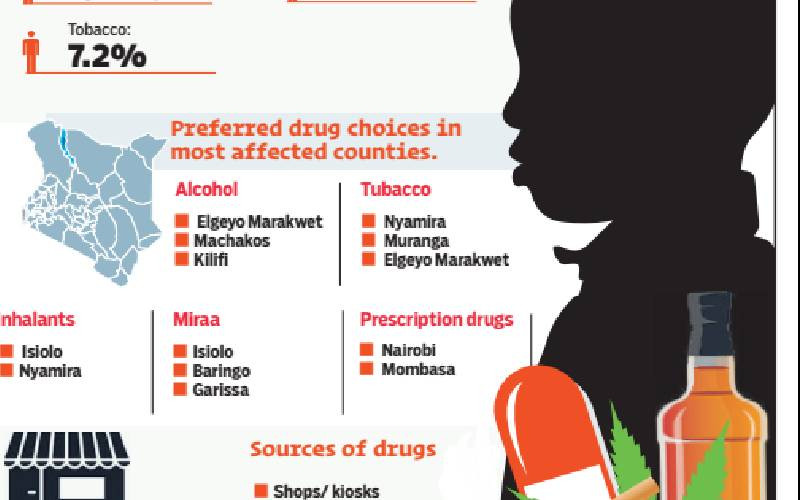
Tobacco is the most abused drug by primary school pupils whereas alcohol is the most abused drug in Kenya, according to a report.
The report by the National Authority for Campaign Against Alcohol and Drug Abuse (Nacada) attributes the abuse of tobacco to peer pressure, mostly at school and exposure at home.
The prevalence of tobacco abuse among pupils, according to the report released yesterday, is 3.2 per cent, representing 156,461.
Alcohol, Khat/miraa and bhang are also highly abused by pupils at 2.6 (127, 124), 2.3 (112,456) and 0.8 (39,115) per cent respectively.
"Alcohol and drug abuse starts at an early age. There is gradual abuse according to education level," said the principal researcher Morris Kamenderi.
According to the report titled National Survey on the Status of Drugs and Substance Use in Kenya, abuse of drugs and substances is also high among secondary school students.
- Youth battle cannabis use and few are breaking free
- How drug abuse threatens fight to end Aids deaths, HIV infections
- How needle sharing, risky traditions are fuelling hepatitis crisis
- Alcohol can seriously affect a young brain
Keep Reading
Alcohol is the most abused drug by secondary school students with a prevalence of 3.8 per cent, representing 82,517, followed by prescription drugs at 3.6 per cent (78,175) and khat/miraa at 2.6 per cent (56,459).
Other drugs abused in secondary schools include tobacco bhang, inhalants, heroin and cocaine at 2.5 per cent (54,288), 1.8 (39,087), 0.6 (13,029), 0.2 (4,343) and 0.2 (4,343) respectively.
"In secondary school, alcohol is the most abused drug, and when they go to universities, they continue to abuse the drugs," added Kamenderi.
Additionally, the report notes that one in every 20 Kenyans aged between 15 and 65, representing 1,357, 040 are addicted to alcohol, with at least one in every 30 Kenyans aged between 15 and 65 (877,627) addicted to tobacco.
Khat is also abused, with one in every 125 Kenyans aged between 15 and 65 (227, 744) addicted to it.
The report added that at least one in every 111 Kenyans aged between 15 and 65 (234, 855) are addicted to cannabis.
Data revealed that an average age category for initiation of tobacco, alcohol, khat, cannabis, prescription drugs, cocaine and heroin stood at between 16 and 20 years.
However, the minimum age of initiation to tobacco was six years, alcohol (7 years), cannabis (8 years), khat (9 years), prescription drugs (8 years), heroin (18 years) and cocaine (20 years).
"One in every six Kenyans aged 15 to 65 (4,733,152) were currently using at least one drug or substance," said the researcher.
Western region had the highest use of at least one drug or substance (26.4 per cent) followed by Eastern (20.7 per cent) and Nairobi (19.1 per cent).
The report added that at least one in every eight Kenyans aged between 15 and 65 (3,199,119) were currently using alcohol, while one in every five males aged 15 and 65 years (2,511,763) and one in every 20 females (687,356) were currently using alcohol.
Overall, the Western region had the highest prevalence of current use of alcohol (23.8 per cent) followed by Coast (13.9 per cent) and Central (12.8 per cent).
Nairobi region had the highest prevalence of manufactured legal alcohol (10.3 percent) followed by Central (10.0 per cent whereas Eastern represented 8.4 per cent.
In the report, Western region had the highest prevalence of use of chang'aa (11.4 per cent) followed by Nyanza (6.3 per cent) and Rift Valley (3.6 per cent).
Traditional liquor remains a menace, with Western region leading in prevalence of current use of traditional liquor at 12.9 per cent, followed by Coast at 7.4 per cent and 2.2 per cent in Nyanza.
Meanwhile, Central region had the highest prevalence of potable spirits at 4.1 per cent, followed by Coast at 3.2 per cent and Rift Valley at 3.1 per cent.
Shockingly, one in every 12 Kenyans aged between 15 and 65, representing 2,305,929, were using tobacco.
The use of tobacco is also high among females, according to the report.
"One in every six males aged 15 and 65 years (2,018,655) and 1 in every 50 females (287,274) were currently using tobacco," adds the report.
Central region had the highest prevalence of current use of tobacco, followed by Coast and Eastern at 11.9, 10.8, and 10.7 percent respectively.
During the launch of the report yesterday, Nacada Acting CEOJohn Muteti said it is worrying that drug barons are using new tactics to smuggle and distribute drugs.
"Shisha is laced with heroin and cocaine. Drug barons are also changing drug tactics, for example, use veterinary drugs," said Prof Muteti.
But even with the ongoing fights to end drug and substance use, Director of Compliance at Nacada James Koskey said the drugs mostly shisha are abused at high-end hotels and palatial homes.
"We conduct a crackdown on drug use after getting an intelligence report, but it is at times hard to get to some of the areas where abuse happens because they do happen at high-end hotels and palatial homes," said Mr Koskey.
Nacada Board of Directors chairperson Stephen Mairori said Nacada will mention barons trafficking drugs and substances.
"Those who bring generation alcohol and other drugs...we know who they are," said Dr Mairori.
Muteti remained optimistic that with goodwill from President Willian Ruto and his deputy Rigathi Gachagua, the fight against drug and substance use will be a success.
The report was launched during a breakfast meeting between Nacada and the Kenya Editors Guild at Sarova Stanley Hotel.
Kenya Editors Guild Trustee Martin Masai encouraged more media engagement with Nacada in the fight against drug and substance abuse.
Media Council of Kenya Deputy CEO Victor Bwire also asked Nacada to engage media personnel more since a number of them are struggling with alcohol and subsatnce abuse.
 The Standard Group Plc is a multi-media organization with investments in media
platforms spanning newspaper print
operations, television, radio broadcasting, digital and online services. The
Standard Group is recognized as a
leading multi-media house in Kenya with a key influence in matters of national
and international interest.
The Standard Group Plc is a multi-media organization with investments in media
platforms spanning newspaper print
operations, television, radio broadcasting, digital and online services. The
Standard Group is recognized as a
leading multi-media house in Kenya with a key influence in matters of national
and international interest.











